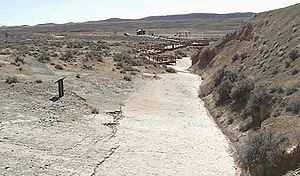
Red Gulch Dinosaur Tracksite
Encyclopedia


Dinosaur
Dinosaurs are a diverse group of animals of the clade and superorder Dinosauria. They were the dominant terrestrial vertebrates for over 160 million years, from the late Triassic period until the end of the Cretaceous , when the Cretaceous–Paleogene extinction event led to the extinction of...
footprints discovered in 1997 on public land near Shell, Wyoming
Shell, Wyoming
Shell is an unincorporated community in Big Horn County, Wyoming, United States.The community is named for the abundance of fossil shells located in the area. Nearby exposed formations such as the Cloverly Formation and the Morrison Formation have yielded numerous fossils of dinosaurs and other...
by Erik P. Kvale, a research geologist from the Indiana Geological Survey
Indiana Geological Survey
Created in 1837, the Indiana Geological Survey is an official agency of the U.S. state of Indiana charged with geological research and the dissemination of information about the state's energy, mineral and water resources. It is located on the campus of Indiana University Bloomington....
. The track
Fossil trackway
A fossil trackway is a type of trace fossil, a trackway made by an organism. Many fossil trackways were made by dinosaurs, early tetrapods, and other quadrupeds and bipeds on land...
s are believed to have been made during the Middle Jurassic
Jurassic
The Jurassic is a geologic period and system that extends from about Mya to Mya, that is, from the end of the Triassic to the beginning of the Cretaceous. The Jurassic constitutes the middle period of the Mesozoic era, also known as the age of reptiles. The start of the period is marked by...
Period, 160-180 million years b.p., on what was then a shore of the Sundance Sea
Sundance Sea
The Sundance Sea was an epeiric sea that existed in North America during the mid to late Jurassic Period of the Mesozoic Era. It was an arm of what is now the Arctic Ocean, and extended through what is now western Canada into the central western United States...
. Theropod
Theropoda
Theropoda is both a suborder of bipedal saurischian dinosaurs, and a clade consisting of that suborder and its descendants . Dinosaurs belonging to the suborder theropoda were primarily carnivorous, although a number of theropod groups evolved herbivory, omnivory, and insectivory...
tracks are thought to be among those discovered, but evidence suggests that the tracks were made by a large, diverse group of dinosaurs. The site is managed by the Bureau of Land Management
Bureau of Land Management
The Bureau of Land Management is an agency within the United States Department of the Interior which administers America's public lands, totaling approximately , or one-eighth of the landmass of the country. The BLM also manages of subsurface mineral estate underlying federal, state and private...
as part of
the Red Gulch/Alkali National Back Country Byway and is open to the public.
Geology
The tracksite is in a limestoneLimestone
Limestone is a sedimentary rock composed largely of the minerals calcite and aragonite, which are different crystal forms of calcium carbonate . Many limestones are composed from skeletal fragments of marine organisms such as coral or foraminifera....
layer in the lower part of the Sundance Formation
Sundance Formation
The Sundance Formation is a western North American sequence of Upper Jurassic age marine shales, sandy shales, and sandstones.The Sundance Formation underlies the western North American Morrison Formation, the most fertile source of dinosaur fossils in the Americas, and is separated by a...
. Its discovery was somewhat surprising, since the Sundance was historically considered to be marine in nature. Indeed, the layer just above the tracksite contains abundant marine fossils including numerous Gryphaea
Gryphaea
Gryphaea, common name Devil's toenails, is a genus of extinct oysters, marine bivalve mollusks in the family Gryphaeidae.These fossils range from the Jurassic to the Cretaceous periods. They are particularly common in many parts of Britain....
nebrascensis, indicating that later in the Jurassic it was once again submerged.

